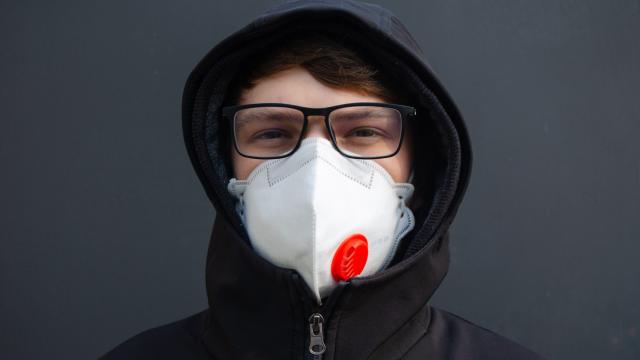If you’re wearing a face mask with a little plastic valve embedded in it, you should know that valves compromise the effectiveness of the mask — and this is true whether your mask is a hardware-store N95 or a designer cloth mask.
These valves allow exhaled breath to bypass the filter. When you breathe in, the air you breathe is being filtered by the mask; when you breathe out, it is not. (The valve only operates in one direction.)
This video from government agency NIST shows how unfiltered air spews from your mask valve with every breath. The person in the valve-less mask still breathes out the same amount of air, but all of theirs is filtered through the mask material.
One-way valves make sense if you’re kicking up sawdust in your basement, walking around California during wildfire season or working in a factory where particles you definitely don’t want to breathe in may be in the air. In these cases, the mask’s job is to protect you. The valve makes it more comfortable to wear so you can get through your day or your factory shift without feeling too stifled. But that’s not why we’re all wearing masks right now.
Why valves don’t make sense for infection control
In the age of COVID-19, we wear masks when out and about for two reasons: First, we hope they might protect us from other people, at least a little bit. (The science on this is not very convincing.) The second reason is more significant: they protect us from infecting others if it turns out we are infected and don’t know it.
Valves defeat that second purpose. A valved mask is letting your breath out unfiltered; the valve acts as a little escape hatch for any virus-laden droplets you’re breathing out. Some municipalities that require masks have specified that masks with valves do not count. You also won’t typically see valved masks in healthcare settings for the same reason. As the CDC explains:
Respirators with exhalation valves should not be used in situations where a sterile field must be maintained (e.g., during an invasive procedure in an operating or procedure room) because the exhalation valve allows unfiltered exhaled air to escape into the sterile field.
If you have a stash of N95s that you previously used as dust masks, or if you’re considering buying a designer cloth mask that has a valve (somehow the fancy ones all seem to have valves), be aware that they only filter your inhaled air, not your exhaled air. And right now, that’s not good enough.
If those masks are all you have, you can tape over the valve, or check whether the valve can be closed (some of the plastic valves on reusable masks can rotate to click closed.) As the saying goes, “your mask protects me, my mask protects you,” so please use a valve-less mask to do your part in reducing transmission.
This post was originally published in April 2020 and was updated on November 11, 2020 to include the video from NIST and a tip about closing or covering the valve on valved masks.

Leave a Reply
You must be logged in to post a comment.